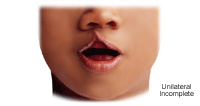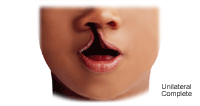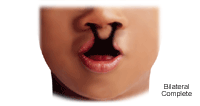Cleft Lip/Cleft Palate
What are cleft lip and cleft palate?
Cleft lip and cleft palate are birth abnormalities of the mouth and lip. In the United
States, nearly 6,800 babies are born with oral clefts annually. These abnormalities
occur less frequently among African-Americans. Cleft lip and cleft palate occur early
in pregnancy when the sides of the lip and the roof of the mouth do not fuse together
as they should. A child can have cleft lip, cleft palate, or both. Cleft lip and cleft
palate together are more common in boys. It is also important to know that most babies
born with a cleft are otherwise healthy with no other birth abnormalities.
Cleft palate
Cleft palate occurs when the roof of the mouth does not completely close, leaving
an opening that can extend into the nasal cavity. The cleft may involve either side
of the palate. It can extend from the front of the mouth (hard palate) to the throat
(soft palate). Often the cleft will also include the lip. Cleft palate is not as noticeable
as cleft lip because it is inside the mouth. It may be the only abnormality in the
child, or it may be associated with cleft lip or other syndromes. In many cases, other
family members have also had a cleft palate at birth.
Cleft lip
Cleft lip is an abnormality in which the lip does not completely form during fetal
development. The degree of the cleft lip can vary greatly, from mild (notching of
the lip) to severe (large opening from the lip up through the nose). As a parent,
it may be stressful to adjust to the obvious abnormality of the face, as it can be
very noticeable.
There are different names given to the cleft lip according to its location and how
much of the lip is involved. A cleft on one side of the lip that does not extend into
the nose is called unilateral incomplete. A cleft on one side of the lip that extends
into the nose is called unilateral complete. A cleft that involves both sides of the
lip and extends into and involves the nose is called bilateral complete.



Cleft lip and cleft palate may occur together in an infant, or separately. The degree
of the abnormality of both cleft lip and cleft palate can vary greatly. The most common
early problem associated with these abnormalities is feeding your baby.
What causes cleft lip and cleft palate?
The exact cause of cleft lip and cleft palate is not completely understood. Cleft
lip and/or cleft palate are caused by multiple genes inherited from both parents,
as well as environmental factors that scientists do not yet fully understand. When
a combination of genes and environmental factors cause a condition, the inheritance
is called "multifactorial" (many factors contribute to the cause). Because genes are
involved, the chance for a cleft lip and/or cleft palate to happen again in a family
is increased, depending on how many people in the family have a cleft lip and/or cleft
palate. If parents without clefts have a baby with a cleft, the chance for them to
have another baby with a cleft ranges from 3% to 5%. If a parent has a cleft, but
no children have a cleft, the chance to have a baby with a cleft is 5 percent. If
a parent and a child have a cleft, the chance is even greater for a future child to
be born with a cleft. Genetic consultation is suggested.
What are the complications associated with cleft lip and cleft palate?
Beyond the cosmetic abnormality, there are other possible complications that may be
associated with cleft lip and cleft palate, including the following:
-
Feeding difficulties. Feeding difficulties occur more with cleft palate abnormalities. The infant may be
unable to suck properly because the roof of the mouth is not formed completely.
-
Ear infections and hearing loss. Ear infections are often due to a dysfunction of the tube that connects the middle
ear and the throat. Recurrent infections can then lead to hearing loss.
-
Speech and language delay. Due to the opening of the roof of the mouth and the lip, muscle function may be decreased,
which can lead to a delay in speech or abnormal speech. Referral to a speech therapist
should be discussed with your child's doctor.
-
Dental problems. As a result of the abnormalities, teeth may not erupt normally and orthodontic treatment
is usually required.
Feeding my baby with cleft palate
The most immediate concern for a baby with cleft palate is good nutrition. Sucking
for children with a cleft palate is difficult because of the poorly formed roof of
the mouth. Children with just a cleft lip (without a cleft palate) do not routinely
have feeding difficulties. The following are suggestions to help aid in the feeding
of your infant:
-
Breastfeeding may take extra time and patience. Be open for alternatives if this is
not providing adequate nutrition for your infant. You may still pump your breast and
feed your infant breast milk through other techniques.
-
Hold your infant in an upright position to help keep the food from coming out of the
nose.
-
Other feeding devices may be utilized. Consult with your child's doctor for more information.
-
Small, frequent feedings are recommended. This can be a frustrating and slow process;
however, your infant will receive more calories, and therefore, gain weight.
There are many types of bottles and nipples on the market that can assist with feeding
an infant with cleft palate. Consult with your child's doctor regarding which type
is most appropriate for your child. The following are a few examples:
-
Dr. Brown's Specialty Feeding System® . This is a unique bottle that has a unidirectional flow valve designed specifically
to assist in the management and treatment of complicated oral feeding issues.
-
Cleft palate nurser® by Mead Johnson. This is a soft, plastic bottle that is easy to squeeze and has a large crosscut nipple.
You may use any nipple that the infant prefers with this system.
-
Special needs bottle® by Medela (also known as the Haberman Feeder). This is a specially designed bottle system with a valve to help control the air the
baby drinks and to prevent milk from going back into the bottle.
Treatment for cleft lip and cleft palate
Cleft lip and/or palate is typically corrected with surgery, but each child may require
a variety of services including dental/orthodontic care before surgery. The Cleft
and Craniofacial team will work with you, your chid, and your pediatrician to determine
the best treatment plan for your child. Treatment options include:
-
Nasal Alveolar Molding
-
Surgery for Cleft Lip
For most infants with cleft lip, the abnormality can be repaired within the first
several months of life (usually between 3 and 6 months of age). This will be decided
by your child's surgeon. The goal of this surgery is to fix the separation of the
lip.
-
Surgery for Cleft Palate
Cleft palate repairs are usually done between the ages of 10 to 12 months. The exact
timing of the surgery will be decided by your child's surgeon. The goal of this surgery
is to fix the roof of the mouth so that your child can eat and learn to talk normally.